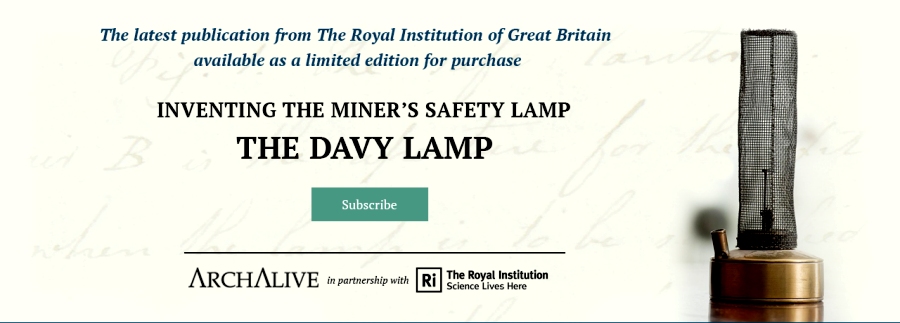Inventing the miner’s safety lamp

“This book is an important record of Davy’s involvement in the development of the miner’s flame safety lamp. Without it, coal production would have stagnated and the industrial revolution would have been stillborn. With the unexpected emergence of George Stephenson as a serious rival, Sir Humphry Davy became very secretive in the critical weeks before he announced his discovery of the wire gauze safety lamp. The drafts for his Royal Society papers are now the key contemporaneous documents from which an insight can be gained into the progress of Davy’s thinking and experiments.” David Rimmer, President, Miners Lamp Collectors Society
200 years ago the Miners’ Safety lamp was deployed, having been invented in December 1815 by Humphry Davy working with Michael Faraday in the Royal Institution of Great Britain. From 1816, the use of the lamp both saved the lives of countless coalminers, and facilitated increased coal production vital to continuing industrialisation. To celebrate, the Royal Institution is publishing a unique bound volume of Davy and Faraday’s original correspondence and successive drafts of the paper that Davy published describing the lamp and its operation.
This limited edition book shows facsimiles of the original manuscripts of Humpry Davy’s papers collected by Michael Faraday and is one of the few primary sources from which the invention & innovation of the lamp can be tracked. Not only did the lamp’s invention have a significant impact on coal mining productivity, it is also a fascinating insight into the process of an invention, appealing to everyone with an interest in the history of science and invention.
Frank A.J.L.James MAE, Professor of the History of Science The Royal Institution of Great Britain & University College London, has edited the book and written an introduction and explanatory notes throughout. Publishing by subscription is one of the oldest models of publishing and has become popular again with specialist books. Davy’s manuscripts have rarely been seen by anyone outside of members of the Ri and certain academics and this book makes them available for the first time to a much wider audience.
______________________
The Royal Institution’s (Ri) purpose is to harness science for the maximum benefit of society. But to achieve the full benefits of what science has to offer, we must ensure there is a healthy and dynamic interaction between science, culture and society. Home to eminent scientists such as Michael Faraday, Humphry Davy and Kathleen Lonsdale, its discoveries have helped to shape the modern world. Just as importantly these scientists recognised the importance of sharing their work with the wider public.
Today it continues its mission as a registered charity providing science education and heritage activities for people of all ages and backgrounds across the UK and around the world. These activities include the world-famous CHRISTMAS LECTURES; public talks from the world’s greatest thinkers in its historic lecture theatre; a national programme of Masterclasses for young people in mathematics, engineering and computer science; hands-on science workshops in its L’Oréal Young Scientist Centre; animations and films from its award-winning Ri Channel and the preservation of its scientific legacy through the Faraday Museum and archival collections.
{{ commodity.name }}
{{ post.title }}
{{ post.date }}

Comments